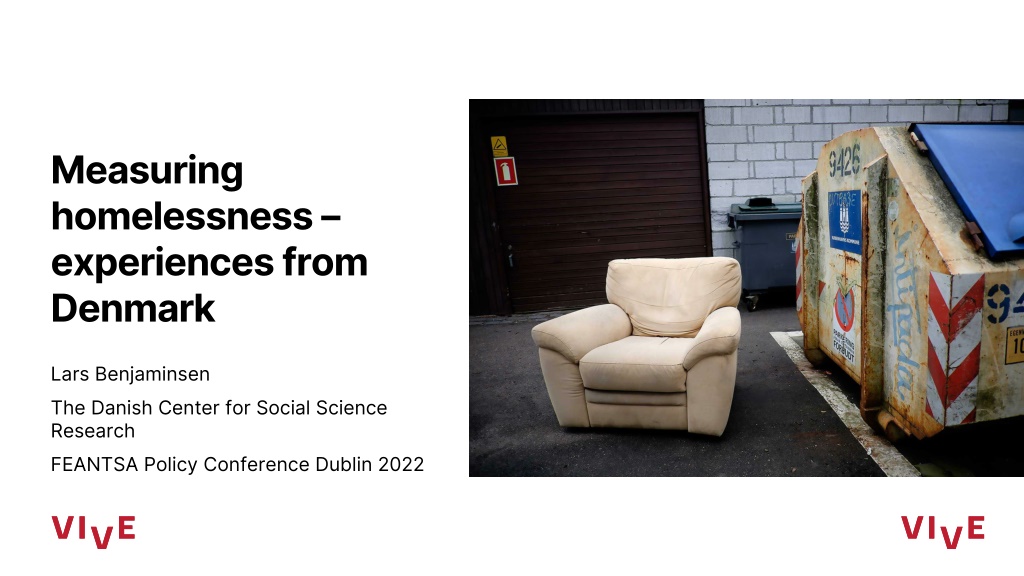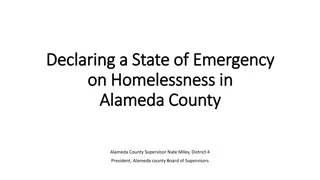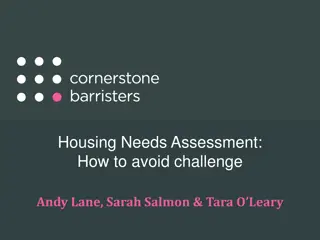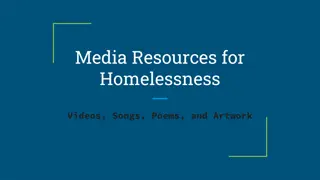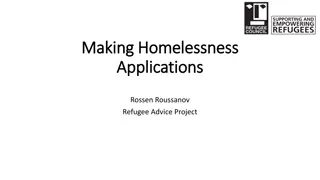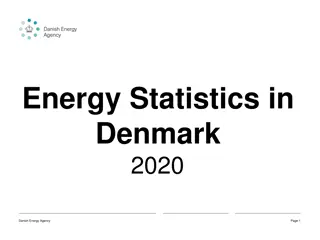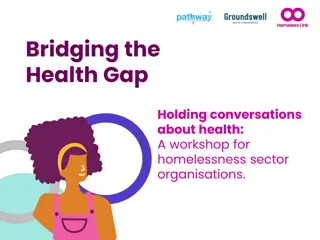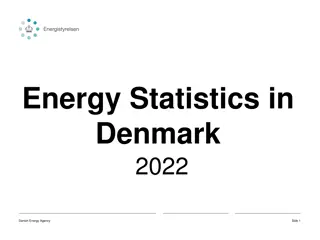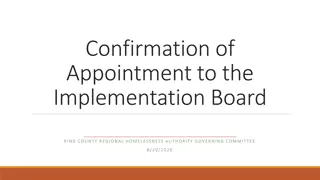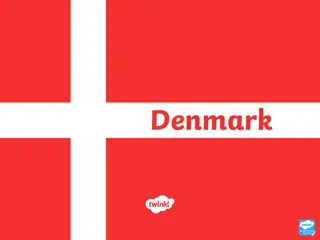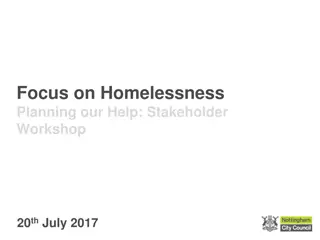Understanding Homelessness in Denmark: Measurement and Perspectives
Exploring the measurement of homelessness experiences in Denmark, this presentation discusses key aspects such as defining and collecting data on different homelessness situations, implications of time-point counts vs continuous measurement, and insights gathered from various data sources. The Danish example showcases two primary data sources on homelessness and provides operational definitions of homelessness situations. The count methodology involves an extended service-based approach using questionnaires for individuals in contact with homeless services.
Download Presentation

Please find below an Image/Link to download the presentation.
The content on the website is provided AS IS for your information and personal use only. It may not be sold, licensed, or shared on other websites without obtaining consent from the author. Download presentation by click this link. If you encounter any issues during the download, it is possible that the publisher has removed the file from their server.
E N D
Presentation Transcript
Measuring homelessness experiencesfrom Denmark Lars Benjaminsen The Danish Center for Social Science Research FEANTSA Policy Conference Dublin 2022
Key aspects The connection between the definition of homelessness and the measurement how can we measure different homelessness situations? How do we collect data on hidden homelessness ? What are the implications of time point in time counts vs. continuous measurement? What information do we get from different types of data and from combining different types of measurement?
The Danish example two main data sources on homelessness National homelessness counts point-in-time count during a count week week 6 in february every second year since 2007 National statistics on shelter use continuous registration of all shelter users nationwide throughout the year since 1999
The Danish homelessness count Definition of homelessness: Conceptual definition: As homeless are regarded people who do not have their own (owner or rented) dwelling or room, but who stay in temporary housing arrangements, or stay temporarily and without a contract with family, friends or acquaintances. As homeless are also regarded people without a place to stay on the following night.
Operational definition homelessness situations Category 1 2 3 4 5 6 7 8 Homelessness situation Stay overnight in the street, a stairway, a shed or the like Stay overnight in an emergency night shelter Stay overnight in a homeless shelter Stay in a hotel due to homelessness Stay temporarily and without a contract at family, friends or acquaintences Stay in temporary transitional housing without a permanent contract Release from prison within a month without a housing solution Discharge from hospital or treatment facility within a month without a housing solution Other 9
Count methodology Extended service based count Not only homeless services but also a wide range of other welfare services Homeless shelters, street outreach teams, psychiatric treatment facilities, addiction centres, municpal social centres, jobcentres, emergency departments, counceling services, etc. Two-page individual questionnare (paper or electronic version) for each homeless person that these services are in contact with or otherwise know is homeless during week 6. Unique identifiers: Personal numbers (Central Person Register identification number) and initials, birthdates control for double counts
Overall trend, count data Homeless people, week 6 7000 Hotels, Institutional release/discharge and other Short term transitional 6000 5000 Family and friends 4000 3000 Homeless Shelter 2000 Emergency Night Shelter 1000 Rough sleeper 0 2009 2011 2013 2015 2017 2019
Profiling of people in different homelessness situations Mental illness (Pct.) Substance abuse (Pct.) Either/or Both (Pct.) 87 87 87 78 77 (Pct.) 44 38 40 24 30 Rough sleepers Night shelter Homeless shelter Hotel Family and friends Short term transitional Release from prison Discharge from hospital Other Total 64 58 57 58 55 70 74 73 50 57 85 82 24 33 59 36 49 80 100 79 84 58 40 38 97 62 59 60 61 66
Second data source: Shelter data Continous registration of shelter users all year round Mandatory across all homeless shelters operating under 110 in the Social Service Act. Nationwide database in Statistics Denmark Additional information on situation upon discharge etc. No profiling information but linking to other administrative data possible
Trend in shelter use Number of shelter users 8000 7000 6000 5000 4000 3000 2000 1000 0
Important learnings from using multiple data sources By only counting shelter users we miss out more than half of the people in homelessness Almost 3 times as many shelter users over a whole year than in a week There is a considerable turn-over in shelter users during a year We have no yearly figure that includes all homelessness categories .since we cannot count homelessness all year around .
What is missing in the Danish data collection? Individual flow/tracking data across services/the welfare system E.g. data on what happens to people after a shelter stay is their situation solved or not? Some data exists on local level but it is not systematic, standardised and centralised it is not collected/available on national level This is a missing link to understanding interventions and a missing piece of information in solving homelessness
